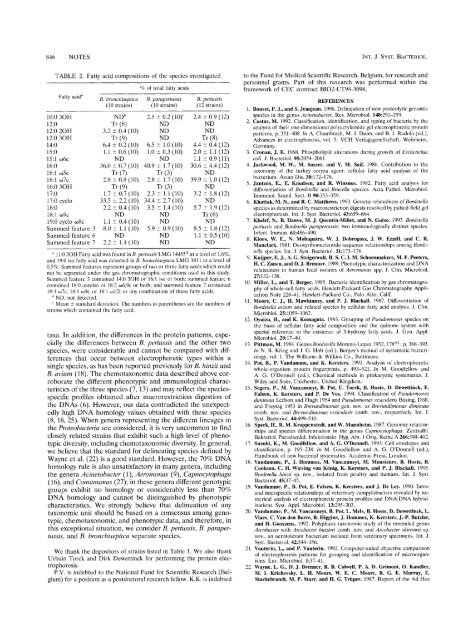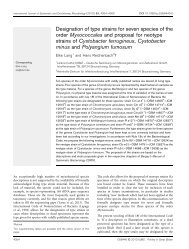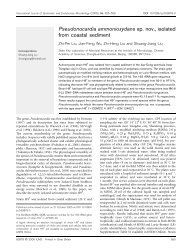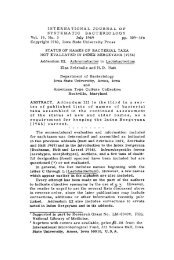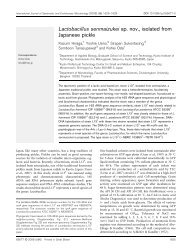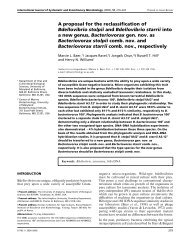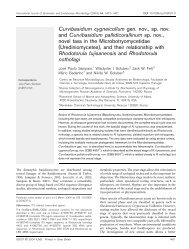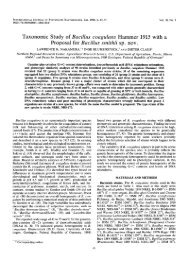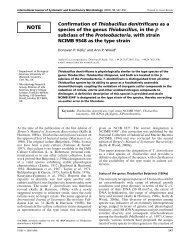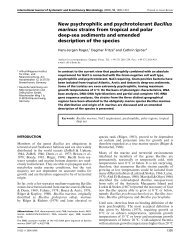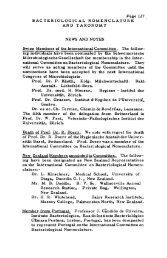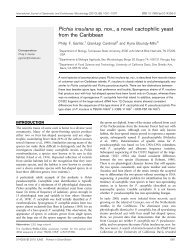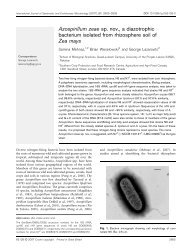Differentiation of Bordetella pertussis, B. parapertussis,
Differentiation of Bordetella pertussis, B. parapertussis,
Differentiation of Bordetella pertussis, B. parapertussis,
Create successful ePaper yourself
Turn your PDF publications into a flip-book with our unique Google optimized e-Paper software.
846 NOTES INT. J. SYST. BACTERIOL.<br />
TABLE 2. Fatty acid compositions <strong>of</strong> the species investigated<br />
~~<br />
% <strong>of</strong> total fatty acids<br />
Fatty acid" B. bronchiseptica R. para<strong>pertussis</strong> B. <strong>pertussis</strong><br />
(10 strains) (10 strains) (12 strains)<br />
10:0 30H ND" 2.5 2 0.2 (lay 2.4 +- 0.9 (12)<br />
12:o<br />
12:O 20H<br />
Tr (8)<br />
3.2 t 0.4 (10)<br />
ND<br />
ND<br />
ND<br />
ND<br />
12:O 30H<br />
14:O<br />
Tr (9)<br />
6.4 +. 0.2 (10)<br />
ND<br />
6.5 f 1.0 (10)<br />
Tr (8)<br />
4.4 t 0.4 (12)<br />
15:o 1.1 +. 0.6 (10) 1.0 t 0.3 (10) 2.0 +- 1.1 (12)<br />
15:l 06c ND<br />
ND 1.1 2 0.9 (11)<br />
16:O 36.0 +. 0.7 (10) 40.9 2 1.7 (10) 30.6 t 4.4 (12)<br />
16:l w5c<br />
16:l 07c<br />
Tr (7)<br />
2.8 t 0.8 (10)<br />
Tr (3)<br />
2.8 ? 1.7 (10)<br />
ND<br />
39.9 t 1.0 (12)<br />
160 30H<br />
17:O<br />
Tr (9)<br />
1.7 t 0.7 (lo)<br />
Tr (3)<br />
2.3 t 1.1 (10)<br />
ND<br />
3.2 t 1.8 (12)<br />
17:0 cyclo<br />
18:O<br />
33.5 t 2.2 (10) 34.4 t 2.7 (10)<br />
2.2 t 0.4 (10) 3.5 +- 1.4 (10)<br />
ND<br />
5.7 t 1.9 (12)<br />
18:l 09c<br />
190 cyclo 08c<br />
ND<br />
1.1 t 0.4 (10)<br />
ND<br />
ND<br />
Tr (6)<br />
ND<br />
Summed feature 3 8.0 f 1.1 (10) 5.9 t 0.9 (10) 8.5 2 1.8 (12)<br />
Summed feature 6 ND<br />
ND 1.1 2 0.5 (10)<br />
Summed feature 7 2.2 t 1.4 (10) ND<br />
ND<br />
1l:O 30H Fatty acid was found in B. <strong>pertussis</strong> LMG 14455"' at a level <strong>of</strong> l.6%,<br />
and lY:0 iso fatty acid was detected in B. bronchiseptica LMG 181 1 at a level <strong>of</strong><br />
0.5%. Summed features represent groups <strong>of</strong> two or three fatty acids which could<br />
not be separated under the gas chromatographic conditions used in this study.<br />
Summed feature 3 contained 14:O 30H or 16:l iso or both; summed feature 6<br />
contained 189 anteiso or 18:2 w6,9c or both; and summed feature 7 contained<br />
18:l w7c, 18:l wYt, or 18:l w12t or any combination <strong>of</strong> these fatty acids.<br />
" ND, not detected.<br />
' Mean t standard deviation. The numbers in parentheses are the numbers <strong>of</strong><br />
strains which contained the fatty acid.<br />
taxa. In addition, the differences in the protein patterns, espe-<br />
cially the differences between B. <strong>pertussis</strong> and the other two<br />
species, were considerable and cannot be compared with dif-<br />
ferences that occur between electrophoretic types within a<br />
single species, as has been reported previously for B. hinzii and<br />
B. aviurn (18). The chemotaxonomic data described above cor-<br />
roborate the different phenotypic and immunological charac-<br />
teristics <strong>of</strong> the three species (7,13) and may reflect the species-<br />
specific pr<strong>of</strong>iles obtained after macrorestriction digestion <strong>of</strong><br />
the DNAs (6). However, our data contradicted the unexpect-<br />
edly high DNA homology values obtained with these species<br />
(8, 18,25). When genera representing the different lineages in<br />
the Proteobacteria are considered, it is very uncommon to find<br />
closely related strains that exhibit such a high level <strong>of</strong> pheno-<br />
typic diversity, including chemotaxonomic diversity. In general,<br />
we believe that the standard for delineating species defined by<br />
Wayne et al. (22) is a good standard. However, the 70% DNA<br />
homology rule is also unsatisfactory in many genera, including<br />
the genera Acinetobacter (l), Aeromonas (9), Capnocytophaga<br />
(16), and Cornamonas (27); in these genera different genotypic<br />
groups exhibit no homology or considerably less than 70%<br />
DNA homology and cannot be distinguished by phenotypic<br />
characteristics. We strongly believe that delineation <strong>of</strong> any<br />
taxonomic unit should be based on a consensus among geno-<br />
typic, chemotaxonomic, and phenotypic data, and therefore, in<br />
this exceptional situation, we consider B. <strong>pertussis</strong>, B. paraper-<br />
tussis, and B. bronchiseptica separate species.<br />
We thank the depositors <strong>of</strong> strains listed in Table 1. We also thank<br />
Urbain Torck and Dirk Dewettinck for performing the protein elec-<br />
trophoresis.<br />
P.V. is indebted to the National Fund for Scientific Research (Bel-<br />
gium) for a position as a postdoctoral research fellow. K.K. is indebted<br />
to the Fund for Medical Scientific Research, Belgium, for research and<br />
personnel grants. Part <strong>of</strong> this research was performed within the<br />
framework <strong>of</strong> CEC contract BI02-CT94-3098.<br />
REFERENCES<br />
1. Bouvet, P. J., and S. Jeanjean. 1986. Delineation <strong>of</strong> new proteolytic genomic<br />
species in the genus Acinetobacter. Res. Microbiol. 140:291-299.<br />
2. Costas, M. 1992. Classification, identification, and typing <strong>of</strong> bacteria by the<br />
analysis <strong>of</strong> their one-dimensional polyacrylamide gel electrophoretic protein<br />
patterns, p. 351-408. In A. Chambrach, M. J. Dunn, and B. J. Radola (ed.),<br />
Advances in electrophoresis, vol. 5. VCH Verlagsgesellschaft, Weinheim,<br />
Germany.<br />
3. Cronan, J. E. 1968. Phospholipid alterations during growth <strong>of</strong> Escherichia<br />
coli. J. Bacteriol. 9520542061.<br />
4. Jackwood, M. W., M. Sasser, and Y. M. Saif. 1986. Contribution to the<br />
taxonomy <strong>of</strong> the turkey coryza agent: cellular fatty acid analysis <strong>of</strong> the<br />
bacterium. Avian Dis. 30172-178.<br />
5. Jantzen, E., E. Knudsen, and R. Winsnes. 1982. Fatty acid analysis for<br />
differentiation <strong>of</strong> <strong>Bordetella</strong> and Brucella species. Acta Pathol. Microbiol.<br />
Immunol. Scand. Sect. B 90:353-359.<br />
6. Khattak, M. N., and R. C. Matthews. 1993. Genetic relatedness <strong>of</strong> <strong>Bordetella</strong><br />
species as determined by macrorestriction digests resolved by pulsed-field gel<br />
electrophoresis. Int. J. Syst. Bacteriol. 43:659-664.<br />
7. Khelef, N., B. Danve, M. J. Quentin-Millet, and N. Guiso. 1993. <strong>Bordetella</strong><br />
<strong>pertussis</strong> and <strong>Bordetella</strong> para<strong>pertussis</strong>: two immunologically distinct species.<br />
Infect. Immun. 61:486-490.<br />
8. Woos, W. E., N. Mohapatra, W. J. Dobrogosz, J. W. Ezzell, and C. R.<br />
Manclark 1981. Deoxyribonucleotide sequence relationships among Bordctella<br />
species. Int. J. Syst. Bacteriol. 31:173-176.<br />
9. Kuijper, E. J., A. G. Steigenvalt, B. S. C. I. M. Schoenmakers, M. F. Peeters,<br />
H. C. Zanen, and D. J. Brenner. 1989. Phenotypic characterization and DNA<br />
relatedness in human fecal isolates <strong>of</strong> Aeromonas spp. J. Clin. Microbiol.<br />
27~132-138.<br />
10. Miller, L., and T. Berger. 1985. Bacteria identification by gas chrornatogra-<br />
phy <strong>of</strong> whole-cell fatty acids. Hewlett-Packard Gas Chromatography Appli-<br />
cation Note 228-41. Hewlett-Packard Co., Palo Alto, Calif.<br />
11. Moore, C. J., H. Mawhinney, and P. J. Blackall. 1987. <strong>Differentiation</strong> <strong>of</strong><br />
<strong>Bordetella</strong> aviurn and related species by cellular fatty acid analysis. J. Clin.<br />
Microbiol. 25: 1059-1062.<br />
12. Oyaizu, H., and K. Komagata. 1983. Grouping <strong>of</strong> Pseudornonas species on<br />
the basis <strong>of</strong> cellular fatty acid composition and the quinone system with<br />
special reference to the existence <strong>of</strong> 3-hydroxy fatty acids. J. Gen. Appl.<br />
Microbiol. 29:17-40.<br />
13. Pittman, M. 1984. Genus <strong>Bordetella</strong> Moreno-Lopez 1952, 17gAL, p. 388-393.<br />
In N. R. Krieg and J. G. Holt (ed.), Bergey's manual <strong>of</strong> systematic bacteri-<br />
ology, vol. 1. The Williams & Wilkins Co., Baltimore.<br />
14. Pot, B., P. Vandamme, and K. Kersters. 1993. Analysis <strong>of</strong> electrophoretic<br />
whole-organism protein fingerprints, p, 493-521. In M. Goodfellow and<br />
A. G. O'Donnell (ed.), Chemical methods in prokaryotic systematics. J.<br />
Wiley and Sons, Chichester, United Kingdom.<br />
15. Segers, P., M. Vancanneyt, B. Pot, U. Torck, B. Hoste, D. Dewettinck, E.<br />
Falsen, K. Kersters, and P. De Vos. 1994. Classification <strong>of</strong> Pseudolnonas<br />
diminuta Leifson and Hugh 1954 and Pseudomonas vesicularis Busing, Doll,<br />
and Freytag 1953 in Brevundirnonas gen. nov. as Brevundimonas diminuta<br />
comb. nov. and Brevundimonas vesicularis comb. nov., respectively. Int. J.<br />
Syst. Bacteriol. 44499-510.<br />
16. Speck, H., R. M. Kroppenstedt, and W. Mannheim. 1987. Genomic relation-<br />
ships and species differentiation in the genus Capnocytophaga. Zentralbl.<br />
Bakteriol. Parasitenkd. Infektionskr. Hyg. Abt. 1 Orig. Reihe A 266:390-402.<br />
17. Suzuki, K., M. Goodfellow, and A. G. O'Donnell. 1993. Cell envelopes and<br />
classification, p. 195-238. In M. Goodfellow and A. G. O'Donnell (ed.),<br />
Handbook <strong>of</strong> new bacterial systematics. Academic Press, London.<br />
18. Vandamme, P., J. Hommez, M. Vancanneyt, M. Monsieurs, B. Hoste, B.<br />
Cookson, C. H. Wirsing von Konig, K. Kersters, and P. J. Blackall. 1995.<br />
<strong>Bordetella</strong> hinzii sp. nov., isolated from poultry and humans. Int. J. Syst.<br />
Bacteriol. 4537-45.<br />
19. Vandamme, P., B. Pot, E. Falsen, K. Kersters, and J. De Ley. 1990. Intra-<br />
and interspecific relationships <strong>of</strong> veterinary campylobacters revealed by nu-<br />
merical analysis <strong>of</strong> electrophoretic protein pr<strong>of</strong>iles and DNA:DNA hybrid-<br />
izations. Syst. Appl. Microbiol. 13:295-303.<br />
20. Vandamme, P., M. Vancanneyt, B. Pot, L. Mels, B. Hoste, D. Dewettinck, L.<br />
Vlaes, C. Van den Borre, R. Higgins, J. Hommez, K. Kersters, J.-P. Butzler,<br />
and H. Goossens. 1992. Polyphasic taxonomic study <strong>of</strong> the emended genus<br />
Arcobacter with Arcobacter butzlen comb. nov. and Arcohacter skirrowii sp.<br />
nov., an aerotolerant bacterium isolated from veterinary specimens. Int. J.<br />
Syst. Bacteriol. 42:344356.<br />
21. Vauterin, L., and P. Vauterin. 1992. Computer-aided objective comparison<br />
<strong>of</strong> electrophoresis patterns for grouping and identification <strong>of</strong> microorgan-<br />
isms. Eur. Microbiol. 1:37-41.<br />
22. Wayne, L. G., D. J. Brenner, R. R. Colwell, P. A. D. Grimont, 0. Kandler,<br />
M. I. Krichevsky, L. H. Moore, W. E. C. Moore, R. G. E. Murray, E.<br />
Stackebrandt, M. P. Starr, and H. G. Triiper. 1987. Report <strong>of</strong> the Ad Hoc


